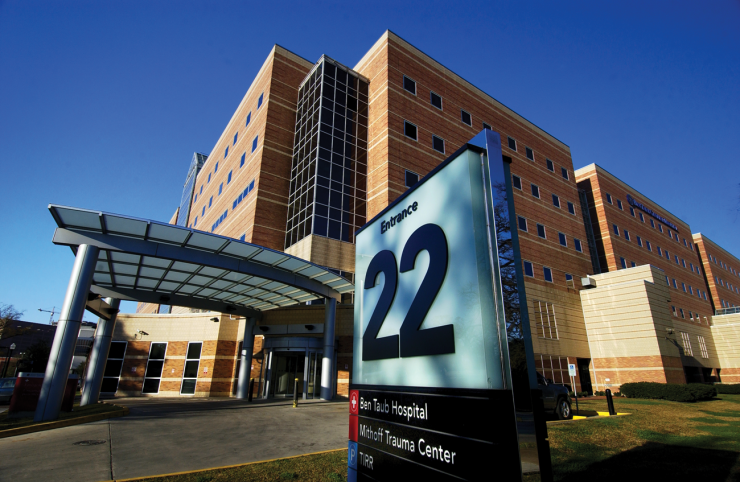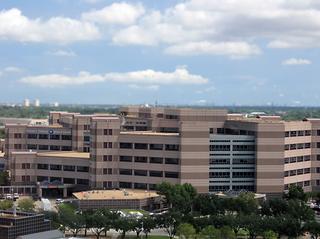
Texas Medical Center
Our residents train in the world's largest medical complex, home to many of the nation's leading hospitals.
Harris Health

Ben Taub Hospital is the primary teaching hospital within Harris Health and is one of two level I trauma centers in the Texas Medical Center. Serving over 1 million Harris County residents, this hospital generates over 23,000 inpatient admissions, 100,000 patient visits through the trauma center, and 145,000 outpatient clinic visits annually.
Approximately half of the rotations in the program are spent within the Harris Health System. The vast breadth of pathology and the high volume of studies mesh well with the hands-on philosophy of our program.
The Smith Clinic, a Harris Health outpatient imaging facility, opened in September 2012. This facility houses state-of-the-art diagnostic imaging equipment with three CT scanners, three MRI scanners, a PET/CT scanner, and numerous ultrasound units. Smith Clinic is also home to the Lester and Sue Smith Breast Center, a facility that has allowed Baylor radiologists to play an integral role in the multidisciplinary Smith Breast Care Center to deliver high-quality breast care to women in the Harris Health System. The facility contains six mammography units, which include the capability to perform tomosynthesis and upright stereotactic biopsies, a dedicated breast MR imaging system with MRI-guided biopsy capacity, one breast stereotactic core needle biopsy unit, and three dedicated breast ultrasound units.
Baylor St. Luke's Medical Center/McNair Campus

Baylor St. Luke’s Medical Center/McNair Campus is the primary private adult teaching hospital for Baylor College of Medicine, and as a tertiary health center, delivers care to patients from around the Houston metropolitan area and from around the world. Residents spend four months of their training at Baylor St. Luke’s: Nuclear Medicine, Cardiac Imaging, Body Imaging and an elective. Because Baylor St. Luke’s is affiliated with the world-famous Texas Heart Institute, the Cardiac Imaging rotation provides immense exposure to dedicated cardiac CTs and MRIs, a unique feature of our residency program.
Texas Children's Hospital
Texas Children’s Hospital is the primary pediatric hospital affiliate of Baylor College of Medicine. TCH consistently ranks among the top pediatric hospitals across the country in a number of subspecialties and is the largest children's hospital in the United States.
Residents spend five months of their residency at Texas Children’s and gain exposure to all of the pediatric radiology subspecialties including ultrasound, CT, MRI, fluoroscopy, plain film radiography, neuroradiology, musculoskeletal radiology, interventional radiology, cardiac imaging, fetal imaging and nuclear medicine. Highlights of the experience at TCH include opportunities to rotate through fetal MRI as well as the state-of-the-art Advanced Image Processing. TCH was the first pediatric hospital in North America to have a PET/MR scanner in clinical use. Few other residencies offer this much dedicated pediatric radiology training, as well as the opportunity to participate in cutting-edge radiology research.
MD Anderson Cancer Center

The University of Texas MD Anderson Cancer Center consistently ranks top in “Cancer Care” in the Best Hospitals Survey published by U.S. News & World Report. It is the largest freestanding cancer center in the world, with over 14 million square feet of equipment and facilities to support outpatient and inpatient care, research, prevention, and education. The Department of Diagnostic Radiology, led by world renowned faculty, conducts more than 500,000 studies each year. Residents rotate through the Thoracic Imaging, Body Imaging and Nuclear Medicine sections during their 2nd, 3rd and 4th years, respectively. MDACC is a premier research institution, and many residents have taken advantage of the opportunity to participate in nationally recognized research in conjunction with MDACC faculty during their time in residency.
Michael E. DeBakey VA Medical Center

The Michael E. DeBakey VA Medical Center is the flagship VA hospital, serving over 130,000 veterans from across the Gulf Coast. Veterans from around the country are referred to the VAMC for sub-specialized care and accordingly, diagnostic and interventional radiology services play central roles in their care. The radiology department is state-of-the-art with four CT scanners (including a dual-energy CT), four MRI scanners and a PET/CT. Residents rotate through services such as Ultrasound, Nuclear Medicine, Body Imaging, Musculoskeletal Imaging and Neuroradiology at the MEDVAMC.








